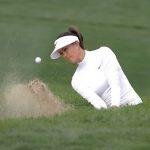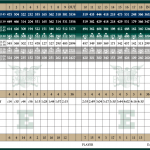Golf has a very high barrier to entry. Most beginner golf players go through degrees of frustration to perfect their shots. The learning curve of golf can be pretty challenging, making it hard to improve skills drastically. People interested in golf are always on a mission to improve their shots and avoid slices. After decades of research, Mike Bennett and Andy Plummer introduced the “Stack and Tilt” golf swing. These new swings were created by combining the physiology and physics related to the game. if you are interested in improving your golfing skills, This article will give you an abstract idea about stack and tilt golf swings.

What Does Stack And Tilt Golf Swing Mean?
Stack and Tilt also have another name called the “New Tour” golf swing. It was first introduced in PGA tour golf coaching in 2005. The new tour swing is almost similar to the traditional swing teachings. The Stack and Tilt focus more on the fundamentals and the physics behind the game, which makes it more efficient. This swing got its name “Stack & Tilt” because the spine tilts through the swing to keep the player more stable and “stacked.”
The mainstream swinging model shifts the upper body behind the ball, leading to inconsistent contacts. On the contrary, Stack and Tilt golf swing keeps the body centered over the ball through the shot. The logic behind this swinging system is if your weight stays in a fixed place, the contact will be consistent. As a result, it will help you to hit the ball solidly. Even though the new tour swing contradicts the old-school teachings, it is more mechanically simple.
Why Did Mike Bennett And Andy Plummer New Tour Swing?

Mike Bennett and Andy Plummer are well-known golf trainers. They researched several golf swings and their efficiency to coach their players more methodically. With the help of science, they worked out a way to easily explore all the golf patterns.
They believed that golf was always unnecessarily challenging because there was no coordination between the fundamental physics of the game and the ball itself. Therefore, they combined physiology and physics to develop the Stack and Tilt golf swing. They based their ideology on the geometric principle, which helped make good shots. Their teaching is more focused on applying the rule of physics and geometric principles to improve your shots. In most cases, players are frustrated with their slices and can’t comprehend what they are doing wrong. Hence, Mike and Andy introduced this new formula so that people can get more tangible results, making their golfing experience more exciting.
This duo introduced their newly developed golf swing model in PGA coaching in 2005, which helped them gain publicity. Renowned professional golf players like Mike Weir and Aaron Baddeley greatly benefitted back in the 2005s when they changed their forms. Aaron Baddeley adapted the new golf swing model and won the game twice. In addition, Mike Weir won in Phoenix in 2007, and by 2008 he had eight top-ten finishes. These were some well-known examples of how Stack and Tilt swing can be a game-changer.
Three Primary Fundamentals
If you read this far, you must be questioning the core elements of Stack and Tilt golf swing. The traditional swing teaches beginners to focus primarily on their grip, stance, and posture, which can become very difficult to master and may ultimately lead to frustration. In contrast, Stack and Tilt swings have more teachable elements which assist beginners in improving their golfing skills. The three essential fundamentals there are: –
- Ability to hit the ground in the same place every time
- Generating enough power to play the course efficiently
- Matching the clubface to the swing path
Let’s break down these three elements of the new tour swing for a better idea.
Ability To Hit The Ground
The ability to control the swing’s low point is a measurable difference between different skilled players. The low end means that when a swing is ideally pulled off, the club head will reach its lowest point, opposite the golfer’s left shoulder. A highly skilled player consistently makes direct contact with the ground every time. On the contrary, beginners may not control their low points, leading to inconsistent contact.
Generating Enough Power To Play The Course Efficiently
Secondly, this element talks about how you need to have enough power to play a course efficiently. The first power element is coordination between the hands and the inward movement of the club. Moving your hands and club on a circular arc can be more powerful compared to moving them straight back. It is because the circular arc movement contains more potential energy. The second power element is to change the form of the spine angle. Through the swing, the main goal is to change the angle of the spine from tilting forward to straightening up. It allows you to raise the club’s speed and make a mighty shot.
Matching The Clubface To The Swing Path
This is where golfers use their knowledge about grip, stance, and posture to control the clubface and swing path. The clubface gives the ball its initial direction, making it crucial to master clubface control. If your clubface is angled to the right of the swing path, the ball will curve to the right, and if it’s angled to the left, the ball will turn to the left. Hence, matching the clubface to the swing path allows you to project the ball towards the target. If you mastered the first two Stack and Tilt golf swing fundamentals, you must learn to launch the ball in a formularized direction.
Essential Elements For New Tour Swing
It is important to learn the primary forms of the Stack and Tilt method to improve your skills. Mike and Andy mentioned six significant elements to know to improve your golf forms.
- Weight forward
- Left shoulder down
- Hands in
- Back leg straight
- Arms straight
- Butt under torso
Weight Forward
To achieve solid contact and hit the ground in the same place throughout the swing, it is vital to set the bodyweight forward. It is recommended to have your weight set up at least 55/45 on the front foot at the address. Make sure you keep your weight ahead throughout the swing, as it will help to swing the club outward. As a result, you will have a better chance to make a perfect shot.
Left Shoulder Down
Left shoulder down is one of the significant key moves in Stack and Tilt golf swing. When the left shoulder goes down during the backswing without moving inward, it helps you to keep your head still. It becomes easier to make circular arc motions when your head is stable. As mentioned earlier, moving the hands and the club in a circular motion is one of the power elements.
Hands In
Hands-in is based on the physics principle called angular momentum. When you swing your hands inward during the backswing, it creates power. It also promotes an outward swing on the downswing, which helps prevent making slices.
Back Leg Straight
Keeping your back leg straight is crucial to maximizing your body rotation on the backswing. When your back leg is straight, it allows your hips and shoulder to turn more. This creates an opportunity for more acceleration and power to play the course efficiently.
Arms Straight
Keeping your arm straight helps prevent making a too far swing across the ball. If you stretch your spine through the shot, it will allow your arms to stay straight. If your arms bend throughout the shot, it will shorten the radius, promoting making a slice.
Butt Under Torso
Learning this form will act as a game-changer, as it is one of the significant power moves. When you push the hips forward and upward, it helps you increase rotation capacity throughout the shot.
You will notice dramatic improvements with these essential elements once you start your practice session. You will be more eager to find out ways to improve your forms. The Stack and Tilt swing elements make engaging and exciting the learning process.
Stack And Tilt Swing VS The Conventional Swing

The new tour golf swing was controversial when it first gained popularity back in 2007. Many veteran golf players commented negatively about it, contradicting the conventional swing. The old school swing model believed in the shift-right model, which instructs the players to shift on their right foot during the backswing. Mike and Andy thought that this was misleading teaching as the shift-right model was very unpredictable, and it was hellish for new players to learn.
Right now, you must question what is the main difference and what makes Stack and Tilt golf swing superior. The comparison table below will you give you a brief idea: –
| Stack and Tilt | Conventional | |
| Weight | The weight set-up needs to be 50/45 on the front foot. | The weight is disseminated 50/50 on both legs. The weight also shifts back and front. |
| Spine angle | Constantly needs to adjust spine angle for shoulders to make circular arc motion. | The spine angle is tilted forward, making the player move behind the ball. |
| Hand path | The hand and the club move in a circular arc movement to efficiently generate enough power to play the course. | The hand extends away from the body, which may contribute to slices. |
| Knee flex | The back leg is straightened during the backswing to maintain maximum rotation. | The back legs stay flexed during the backswing. |
| During the impact | There are no rolls in the wrist or arms in Stack and Tilt swing. The arms are always straight. | The wrist and arm roll may shorten the radius during the shot and lead to a slice. |
| Follow-Through | The hip makes a “reverse C” position as it thrusts forward. It helps to increase your body rotation. | The hip is not pushed forward, which doesn’t let the player maximize their rotation capacity. |
Benefits And Drawbacks
At this stage, you must consider the benefits and drawbacks of the new tour swing to evaluate if this approach is for you.
Benefits
- Flawless execution of the swing can prevent the loss of distance to your shots.
- New players can practice solid contacts more easily with the Stack and Tilt model.
- If you want an outstanding ball flight, this approach will be your go-to.
- Stack and Tilt swings are beneficial for inconsistent players with ball striking.
Drawbacks
- This approach is suitable for people who have great physical strength and flexibility.
- The Stack and Tilt model may not be ideal for senior golfers.
- Many critics claim that this swinging model can put a lot of undue stress on muscles and joints.
Ultimately, it is up to you if Stack and Tilt golf swing will be beneficial for you or not. You can take some time and analyze your golfing skills to evaluate the situation of your game. If you notice that you are missing to make consistent solid contacts, this new tour swing can assist you. Moreover, it is not mandatory to use all the elements of Stack and Tilt; you can improvise and improve your skills. Even though the traditional swing is taught everywhere, it is proven that Stack and Tilt can change your golf experience. The Stack and Tilt swing can make your learning experience more thrilling.
Final Thoughts
It may seem difficult to master golf skills, but Stack and Tilt’s simple mechanism helped tour players understand the game better. There were a lot of critics of imposing this new swing model. However, at the same time, many tour players improved their skills by adapting the Stack and Tilt model.
It is okay if the Stack and Tilt golf swing does not work perfectly. You can improvise and follow a few parts from the basic foundation of the model to get better at the game. There is no harm in trying new methods to improve your game skills. If you want to read more about this, you can purchase the book “The Stack and Tilt Swing” written by Mike Bennett and Andy Plummer.








